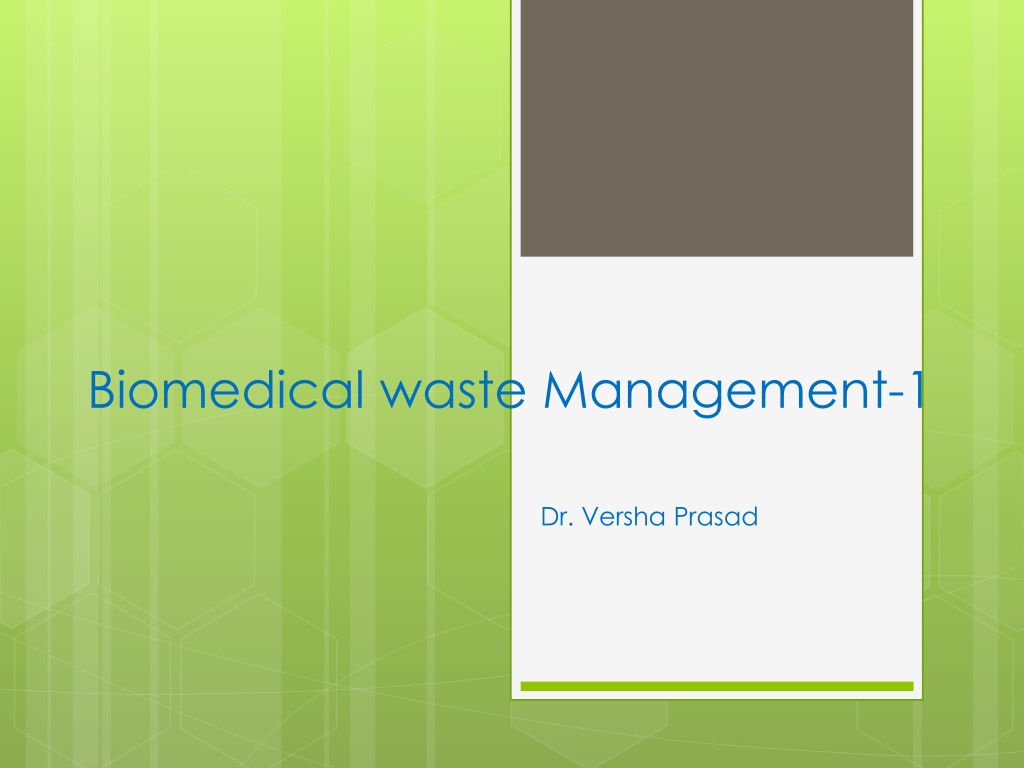Effective Biomedical Waste Management: Ensuring Public Health and Environmental Safety
Proper management of biomedical waste is crucial to prevent serious public health risks and environmental impacts. The World Health Organization estimates significant infections from contaminated syringes, highlighting the urgent need for efficient segregation and disposal practices. Categorized waste types and appropriate handling methods, such as using yellow and red bins, are essential for effective biomedical waste management systems.
Download Presentation

Please find below an Image/Link to download the presentation.
The content on the website is provided AS IS for your information and personal use only. It may not be sold, licensed, or shared on other websites without obtaining consent from the author. Download presentation by click this link. If you encounter any issues during the download, it is possible that the publisher has removed the file from their server.
E N D
Presentation Transcript
Biomedical waste Management-1 Dr. Versha Prasad
Need for BMW management BMW may have serious public health consequences and a significant impact on the environment! WHO has estimated that. . . In year 2000, injections with contaminated syringes caused: 21 million hepatitis B virus (HBV) infections (32% of all new infections) 2 million hepatitis C virus (HCV) infections (40% of all new infections) 2.6 million HIV infections (5% of all new)
STEPS INVOLVED-Segregation It refers to the basic separation of different categories of waste generated at source Reduces the risks and cost of handling and disposal Effective segregation alone can ensure effective bio-medical waste management
CATEGORIES OF BMW Category Category Type of Bag/container Type of Bag/container used used Non-chlorinated plastic bags Separate collection system leading to effluent treatment system Type of waste Type of waste Yellow a. Human anatomical waste b. Animal anatomical waste c. Soiled waste d. Expired or discarded medicines e. Chemical waste f. Micro, other clinical lab waste g. Chemical liquid waste
Category Category Type of Bag/container Type of Bag/container used used Non-chlorinated plastic bags or containers Type of waste Type of waste Red Contaminated waste (Recyclable) Tubing, bottles, IV tubes and sets, catheters, urines bags, syringes (without needles) and gloves Waste sharps including Metals White (Translucent) Puncture, Leak, tamper proof container Cardboard boxes with blue colored marking Blue Glassware
Yellow Bin Human and animal anatomical waste, soiled waste, expired or discarded medicines, chemical solid and liquid waste, microbiology, biotechnology and other clinical laboratory waste
Red Bin Contaminated Waste (Recyclable) Wastes generated from disposable items such as tubing, bottles, intravenous tubes and sets, syringes (without needles and fixed needle syringes) and vacutainers with their needles cut) and gloves
Blue Bin Glassware Broken or discarded and contaminated glass including medicine vials and ampoules except those contaminated with cytotoxic waste.
White Container Waste sharps including Metals Needles, syringes with fixed needles, needles from needle tip cutter or burner, scalpels, blades, or any other contaminated sharp object that may cause puncture and cuts. This includes both used, discarded and contaminated metal sharps.
BMW PRE-TREATMENT (YELLOW CATEGORY) On-site pre-treatment of laboratory waste, microbiological waste, blood samples, blood bags Methods Chemical disinfection Autoclave
BMW Pre-treatment (yellow category) Chemical/liquid waste Some chemicals require pre-treatment before they can be safely disposed of by other types of disposal methods. Liquid laboratory wastes that are commonly disposed of in the sink include used buffer solutions, neutralized acids and caustics, and very dilute aqueous solutions of water-soluble organic solvents (e.g., methanol, ethanol). Any form of liquid waste should be diluted with at least a 100-fold excess of water or with a large excess of water up to 10 gallons. Acids should be neutralised with an equal volume of a base and further diluted in water to flush into the sink.
BMW Pre-treatment (yellow category) Autoclaving Each autoclave should have graphic or computer recording devices which will automatically and continuously monitor and record dates, time of day, load identification number and operating parameters throughout the entire length of the autoclave cycle. All records to be kept for 05 years.
storage of BMW The bags containing lab waste are brought for safe retention to the temporary storage facility till they are disposed off. Transport Offsite transport is the carriage of health-care waste on the public streets away from a health- care facility Biomedical Waste from storage area is transferred to the common regional facility for BMW final disposal
Important Biomedical Waste Management Rule a. The scope of the rules has been expanded to include vaccination camps, blood donation camps, surgical camps or any other healthcare activity b. Phase-out the use of chlorinated plastic bags, gloves and blood bags within two years c. Pre-treatment of the laboratory waste, microbiological waste, blood samples and blood bags through disinfection sterilization on-site in the manner as prescribed by WHO
Important Biomedical Waste Management Rule d. Provide training to all its health care workers and immunize all health workers regularly. e. Establish a Bar-Code System for bags or containers containing bio-medical waste for disposal. f. Report major accidents g. BMW has been classified in to 4 categories instead of 10 to improve the segregation of waste at source yellow, red, white and blue h. No occupier shall establish on-site treatment and disposal facility, if a service of `CBMWTF is available at 75 km. i. Operator of a CBMWTF to ensure the timely collection of bio- medical waste from the HCF and assist the HCF in conduct of training.

 undefined
undefined
































